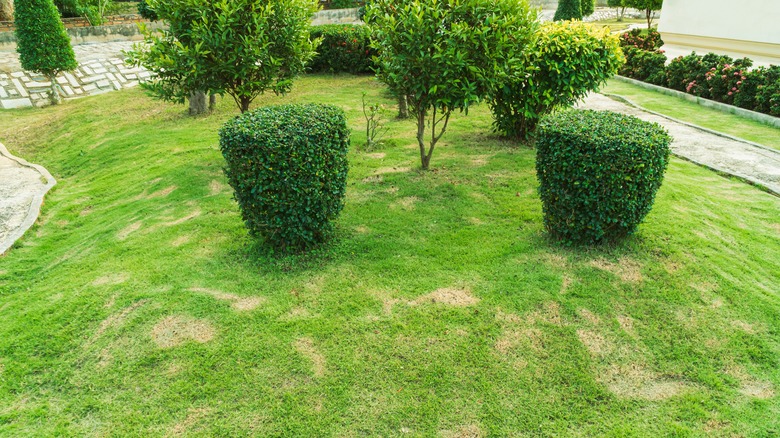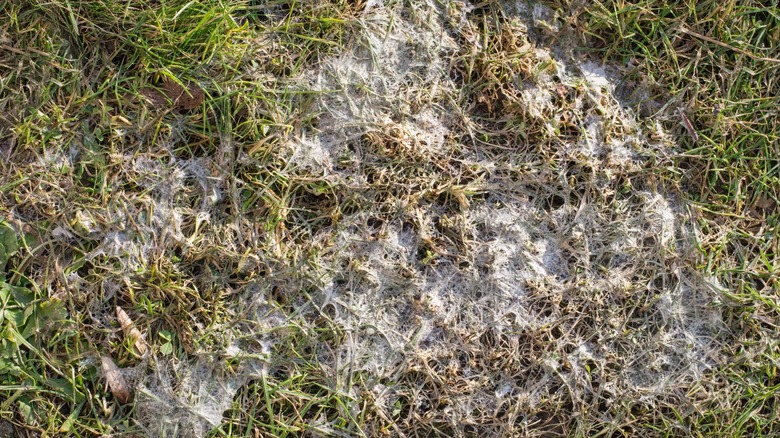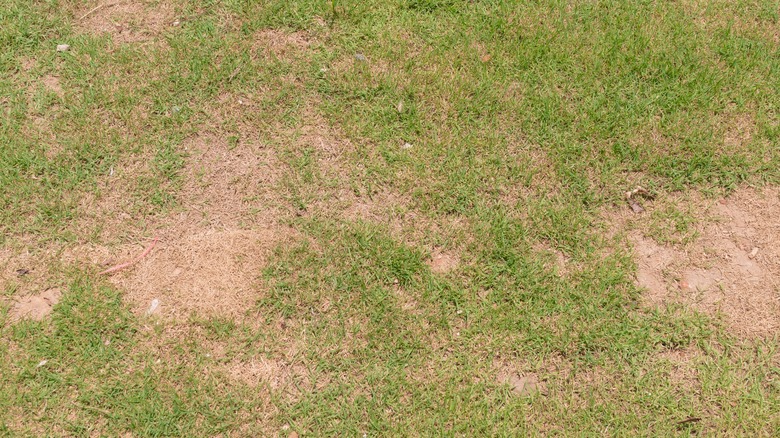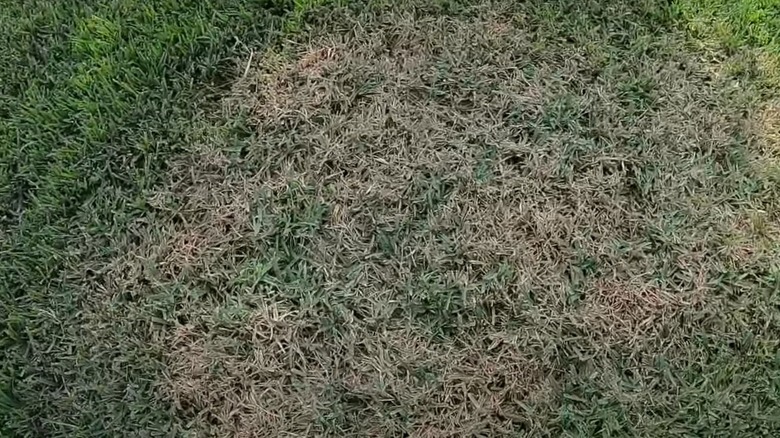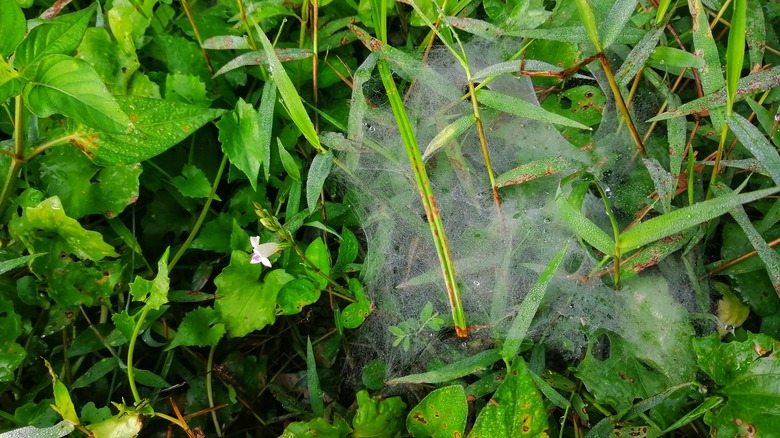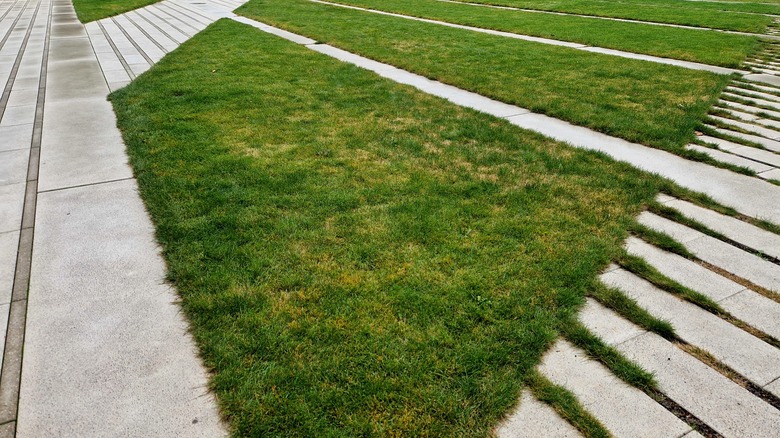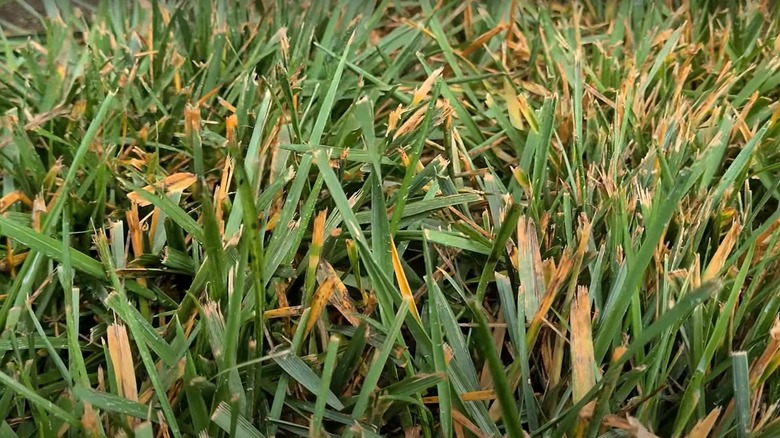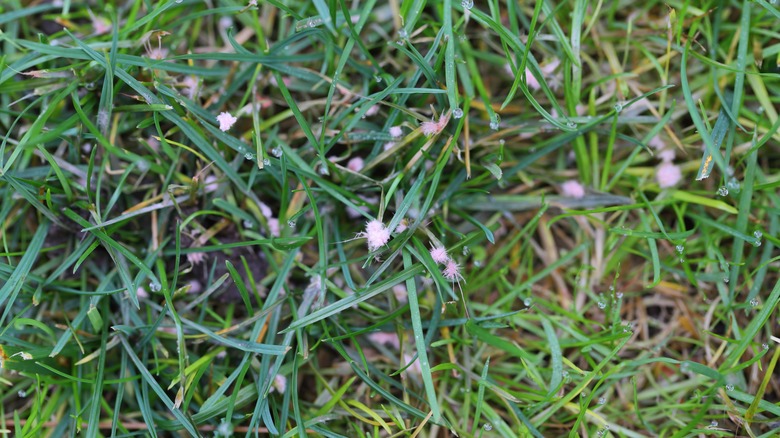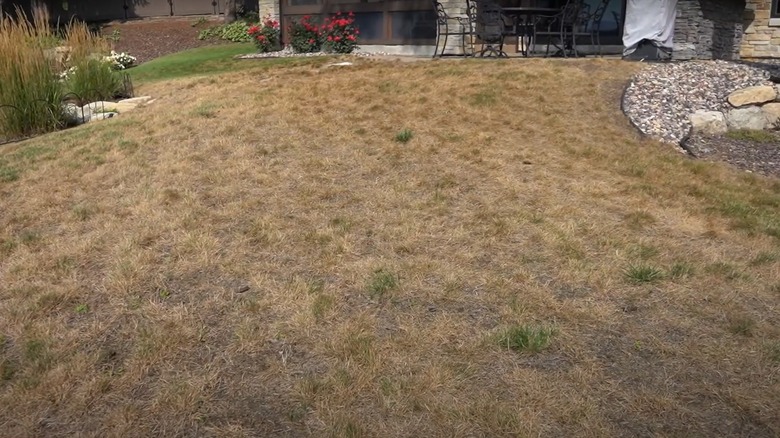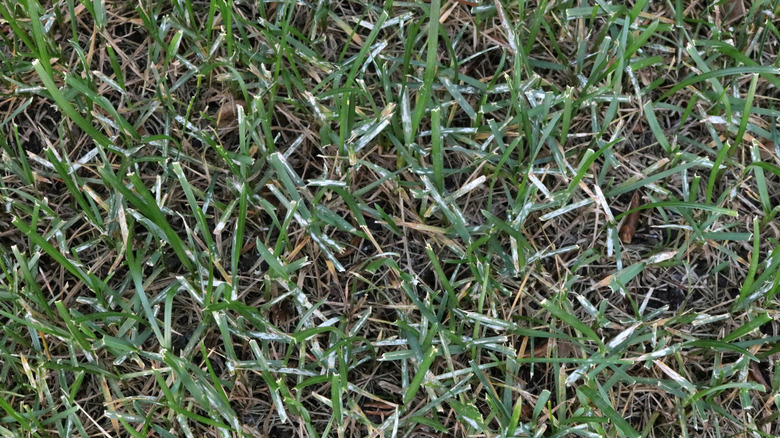9 Common Lawn Diseases And The Reasons They Occur
When you put a lot of time and effort into keeping your lawn and garden looking their best, it can be exceedingly frustrating to find patches of dead, brown, or otherwise diseased grass. Even if these areas are small, they still detract from the overall aesthetics of the lawn. Plus, there is always the concern that the disease will spread to other areas of the grass, taking over your whole yard.
Unfortunately, there are several types of lawn diseases, so there isn't a one-size-fits-all solution to clear them up or to prevent them from happening in the first place. If you aren't a professional, it can be challenging to differentiate between them to understand the best approach for rescuing and restoring your lawn. To help you better understand the various diseases and your options, House Digest spoke exclusively to several lawn care experts. They shared valuable info for identifying, treating, and preventing some of the most common ones.
Your lawn may become diseased with snow mold as the winter snows start melting
As you may guess, snow mold is a lawn disease that is most likely to occur around snowfalls, particularly as the weather begins to warm up enough to start melting the snow. In an exclusive interview with House Digest, Brad Saunders, president of Heroes Lawn Care, said, "What you'll notice are straw-colored patches of grass, matted down with white or tan coloring. If you take a closer look (maybe even under a microscope), you might spot reddish-brown spots on the blades and some thread-like material that looks a bit like spider webs."
The reason this fungus pops up in the spring is because of the damp conditions that are created when the grass is covered by heavy and wet snow. Patches of snow mold are often grayish-white in color, but some may also have a whitish-pink hue. Patches of pink snow mold can be more problematic as they kill more than just the individual blades of grass, but also the roots and crown of the plant.
Saunders shares some tips for caring for snow mold-damaged grass and even preventing it from occurring in the first place. "The best way to handle snow mold is to focus on thinning out any thatch before winter hits, which helps prevent the grass from staying too damp under the snow. Once the snow melts, give your lawn a light raking to let air in and help dry things out," he says. As a preventative measure, Saunders recommends making sure snow isn't piled up in one spot on the grass. You may also need to apply a pre-winter fungicide or reseed damaged areas in the spring.
Brown patch can occur during periods of high humidity and warm temperatures
Brown patch is another lawn disease that you should learn how to treat, and, ideally, avoid. "If you're the curious type and look under a microscope, you'll see light brown or tan lesions with dark borders on the leaf blades," explains Saunders. It is most likely to plague lawns during periods of high humidity and typically targets cool-season grasses. If you have northern grasses comprising your lawn, be alert between June and August, when the conditions will be most favorable for it to pop up. Brown patch is also more prevalent among grass that is not cut short enough.
Because the lawn disease is most likely to occur in an environment that is wet and humid, Saunders recommends reducing how much you water your lawn. He also notes the importance of watering in the morning so that the excess water can evaporate during the heat of the day. But there are other things you can do to prevent the fungus from cropping up. "Mowing your grass a bit lower can help with airflow, which can reduce how often you see this problem. Aerating the lawn to improve drainage also helps," says Saunders. You can also use a targeted fungicide if brown patch has already taken over your lawn, as well as limiting how much nitrogen-rich fertilizers you add to the area.
Cool and damp weather may make a lawn more susceptible to large patch disease
Large patch is a disease that is similar to brown patch. In fact, the two diseases are often discussed as the same thing, but other than being caused by the same fungus, the two diseases are distinct. Brown patch typically affects cool-season grasses, such as bluegrass, ryegrass, and fescue. Large patch, on the other hand, is more common with warm-season grasses like centipedegrass, zoysia, and St. Augustine grass.
During an exclusive interview, Director of Technical Operations at TruGreen, Marc Mayer, told House Digest that large patch disease is, "most common in the spring and fall when the grass is going through its transition period." He explains, "Cool and wet weather can accelerate this disease and cause areas of the turf to decline." The disease may also be more likely to occur when there is poor drainage or too much nitrogen in the soil.
You can identify large patch disease by the imperfect ring shapes that it leaves behind in the lawn. Protect your warm grass against large patch disease by watering in the morning and aerating to ensure proper drainage. In some cases, you might also want to apply a fungicide to prevent the disease from spreading and affecting larger portions of your lawn.
Lawns with a nitrogen deficit may be susceptible to dollar spot
Low-mowed lawns are most susceptible to dollar spot disease. "The disease shows up as small, white or tan spots about the size of a dollar coin. You might also see white thread-like material on the blades. Under a microscope, those spots may have yellow-green blotches that turn into tan lesions with reddish-brown edges," explains Saunders. The region of the country and the type of grass you have can determine when your lawn is most likely to be affected by dollar spot disease. According to Saunders, cool-season grasses may face this disease between the months of April and November, while warm-season grasses are more likely to be affected between May and September.
Saunders also notes that grass that has a nitrogen deficit is typically more likely to be affected by dollar spot. He says, "Feeding your lawn with a good fertilizer can help it bounce back. Avoid cutting the grass too short — raising the mower blades a bit will help. If you water, do it early in the day so the grass can dry out." Depending on how quickly you catch it and how effective your attempts to get rid of it are, Saunders recommends using a targeted dollar spot fungicide to treat the lawn.
Fungi that grow in humid environments could cause rust disease on your lawn
Rust disease is aptly named because of the powdery, rust-colored residue that it produces when allowed to progress. Lawns with poor soil conditions and stressed, slow-growing grass are more prone to this disease. However, if you act quickly, you may be able to prevent the disease from progressing and creating this messy residue that can rub off on your clothing, shoes, gardening tools, and more. "At first, you'll notice small, yellow speckles on the blades. As it worsens, those yellow spots grow and align themselves in rows along the veins of the grass. Eventually, the disease creates reddish-brown spores." says Saunders. The reddish-brown spores are responsible for the powdery residue.
Fortunately, there are things you can do to prevent rust disease from getting worse and to clear up your lawn. Start acting as soon as you notice any early signs of rust fungus. Saunders recommends trying to get the grass to grow more quickly. "Regular fertilizing helps, as does mowing more frequently without cutting too much off the top. Improving airflow and sunlight by trimming back trees or shrubs is another option." He also notes that fungicides might be necessary for lawns where the disease has spread and affected large patches of grass. The time when you're most likely to notice rust disease can vary by region. Those with warm-season grasses are most likely to face the challenge it poses between May and October, while those with cool-season lawns will most likely notice it during the early autumn.
Warm and damp conditions have the potential to cause leaf spot disease on your lawn
If your goal is to have a lush, green lawn, then you're sure to be frustrated if you notice any signs of leaf spot. "It shows up as tiny brown spots on the grass blades, and as the disease progresses, those spots get darker, with purplish-red borders around centers," shares Saunders. It is most likely to occur between April and September on warm-season lawns, or between April and June or August and September for cool-season lawns. According to Saunders, "Warm, wet weather creates ideal conditions for leaf spot, particularly in overwatered or dense lawns with poor air circulation."
Knowing these ideal conditions for the disease are key to prevent leaf spot from taking over your lawn. Saunders recommends watering in the earlier morning hours to ensure that the grass dries and doesn't remain damp. Another tip he adds is to aerate your lawn. He says that doing so, "can help improve drainage, which also cuts down on the wet conditions leaf spot loves." While fungicides can be used to treat leaf spot, Saunders highlights that taking these preventative measures can be quite effective.
Red thread is a fungal disease that is most likely to occur when it is wet or humid
Yet another fungal disease that you're most likely to find in wet and humid conditions is red thread. During an exclusive interview with House Digest, Lawn Love CEO, Jeremy Yamaguchi, explained the two stages of red thread disease. "In the first stage, red, thin needle-like strands extend from the grass blade. These strands are called stromata, and they infect the grass blade after germinating. Stromata can remain active in the soil for up to two years," he says. Then, when the conditions are favorable (wet and humid), Yamaghuchi explains how web-like mycelium form along the areas where the grass blades touch one another. These mycelium, which are fuzzy and pink, will make the lawn look like it has tan or pink patches all over it when viewed from a distance.
To minimize the chances of red thread forming, and to manage it, Yamaguchi recommends aerating and dethatching the lawn. These measures will allow for proper drainage and prevent the grass and soil from remaining too damp, encouraging the fungus to form. He also shares that fungicides can be an effective treatment for this lawn disease.
Summer patch can cause grass to turn brown as the soil temperatures warm up
As the air temperature gets warmer in the summer, the soil temperature also increases. According to Mayer, "When soil temperatures start to creep up around 65 degrees in the North, homeowners may notice signs of summer patch lawn disease." He explains that this lawn disease causes the color of the blades to change from yellow to brown. The changing colors will first be noticeable at the tip of the leaf and then will progress to the bottom of each blade, changing the entire thing and leaving yellowish-brown patches across the lawn.
"Proper diagnosis is key to reducing disease damage on your lawn," says Mayer. In severe cases, he notes that the use of a fungicide may be necessary to prevent the disease from affecting more areas of the lawn. After the summer months have passed, taking steps in the fall can help your lawn recover and prepare for a healthy spring and summer the next season. Mayer highlights aeration, fertilization, and a well-thought-out watering plan as important to ensure the health of your lawn. He adds, "For cool-season lawns, overseeding in the fall will help build density and improve the health of your lawn as it prepares for winter conditions. When picking the right seed, focus on disease-resistant turf species."
Powdery mildew is a gray fungus that can create patches over your lawn
When you visualize a perfectly landscaped and well-kept yard, we're willing to bet that the image that comes to mind doesn't involve white powder scattered all over your lawn. Unfortunately, that's precisely what your grass can look like if it is diseased with powdery mildew. Chrissy Handley, a lawn care specialist working for Online Turf told House Digest in an exclusive interview, "Powdery mildew is easily identifiable as a light, grey-ish cobweb-style fungus covering your grass. If you look closely, you can see that it forms in small patches and clumps together (earning its name 'powdery' as it's similar to sprinkling talcum powder on your lawn) eventually coating most of the grass blade."
Handley says that damp and humid conditions are to blame for this lawn disease. To protect your lawn against getting plagued by powdery mildew, she recommends mowing the lawn to the correct height (which can vary depending on the type of grass you have). It's also important to properly maintain your lawn and clean up debris, especially when the humidity rises.
